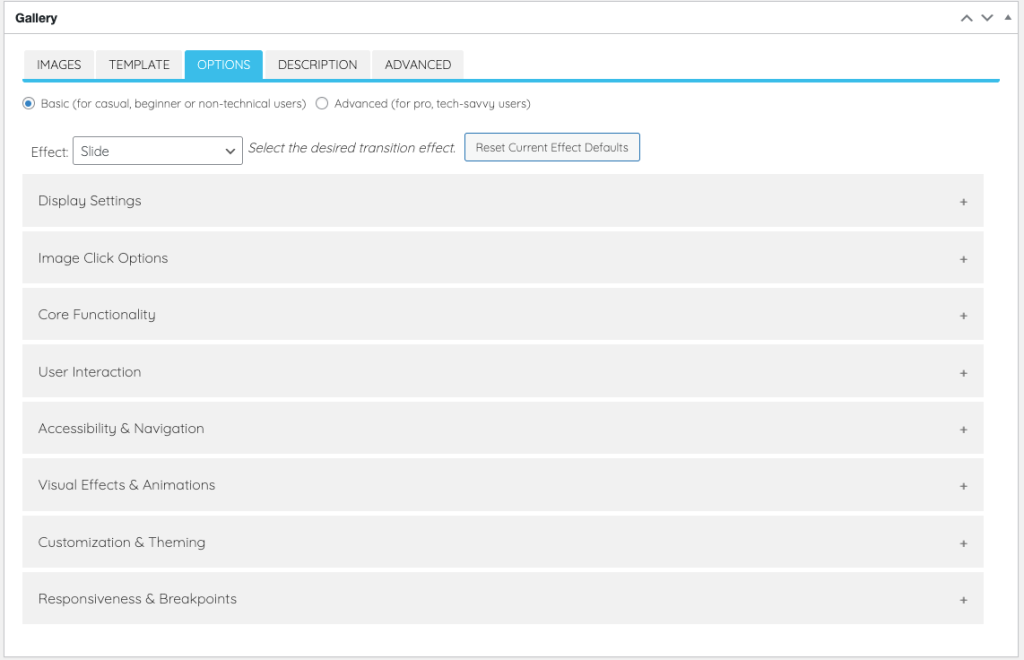Keyboard Navigation – Enable users to navigate slides using the keyboard.
Keyboard In Viewport Only -Limit keyboard navigation to when the Swiper is in the visible area.
Keyboard PageUp/PageDown – Allow PageUp and PageDown keys to move between slides.
Mousewheel Enabled – Enable scrolling through slides with the mousewheel.
Mousewheel Release On Edges – Allow scroll events to pass through when the Swiper reaches the first or last slide.
Mousewheel Invert – Reverse the scroll direction.
Mousewheel Force To Axis – Make scrolling follow the closest slide axis (horizontal/vertical).
Mousewheel Sensitivity – Control how much scrolling is needed to change slides. Higher = more sensitive.
Mousewheel Events Target – Set where the scroll event is captured, like the Swiper container.
Hash Navigation – Change the URL hash as you move through slides for easier linking.
Hash Navigation Replace State – Avoid adding multiple history entries as you slide.
Hash Navigation Watch State – Swiper updates when the URL hash changes.
History Enabled – Let Swiper use the browser history for navigation.
History Root – Define the base URL path for history navigation.
History Replace State – Avoid adding new history entries when changing slides.
History Key – Set a custom key to track Swiper in browser history.
Accessibility (A11y) – Add ARIA attributes and keyboard support for screen readers and improved accessibility.
Pagination
Select the style of pagination (e.g., bullets, fraction, progress bar).
Clickable – Let users click bullets to navigate.
Render Total – Show the total number of slides in the pagination.
Render Visible – Only show bullets for visible slides.
Slides Per Column – Set how many slides appear in a vertical column.
Slides Per Column Fill – Determine how slides are arranged in multi-column layout.
Slides Per Column Centered – Center the slides in the column layout.
Navigation
Enable next/prev buttons.
Next Element (CSS selector) – Set the element used to go to the next slide.
Previous Element (CSS selector) – Set the element used to go to the previous slide.
Navigation Disabled Class – CSS class added to nav buttons when they are disabled.
Navigation Hidden Class – CSS class used to hide nav buttons when not needed.
Navigation Lock Class – CSS class added when nav buttons are locked from use.
Navigation Container Disabled Class – CSS class applied to the Swiper container when nav is disabled.
Unique Nav Elements – Use buttons that are specific to this Swiper instance (not shared globally).
Hide On Click – Hide navigation buttons when the user clicks on the Swiper.
Scrollbar
Enable a draggable scrollbar for navigation.
Scrollbar Element – CSS selector or element to attach the scrollbar to.
Scrollbar Hide – Automatically hide scrollbar when not used.
Scrollbar Draggable – Allow users to drag the scrollbar.
Scrollbar Drag Size – Set the size of the scrollbar handle (auto or specific value).
Scrollbar Snap On Release – Snap to the nearest slide after releasing the scrollbar.
Scrollbar Lock Class – CSS class added when the scrollbar is locked.
Scrollbar Drag Class – CSS class for styling the draggable scrollbar handle.
Scrollbar Disabled Class – CSS class for the scrollbar when it’s disabled.
Lazy Loading
Lazy Preload Previous/Next – How many slides before and after the current one to preload for smoother navigation.
Lazy Preloader Class – CSS class for the loading spinner shown during image lazy loading.
